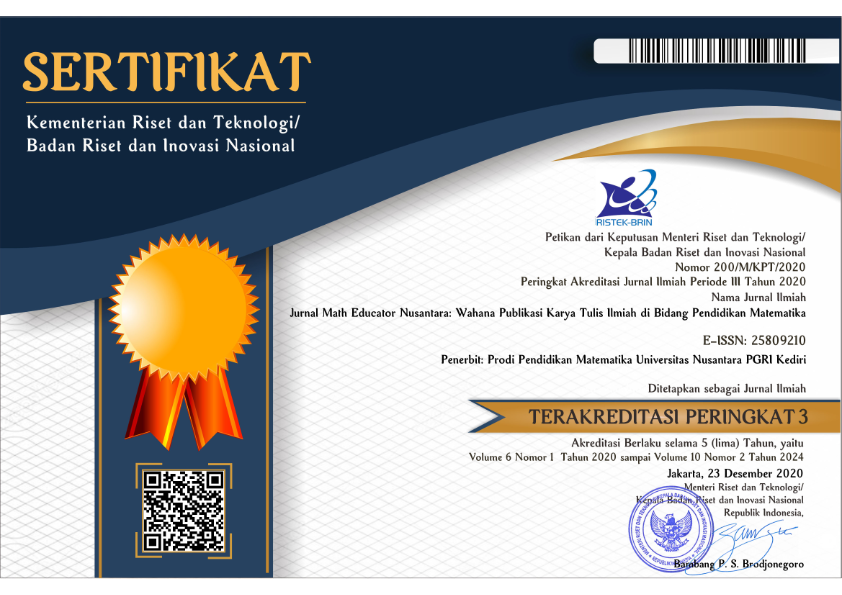Learning difficulties of mathematic students on real analysis courses with an online system
DOI:
https://doi.org/10.29407/jmen.v7i1.14766Keywords:
Learning Difficulties, Online Learning, Real AnalysisAbstract
The aim of this research to describe the learning difficulties of Mathematic Student on Real Analysis with an Online System. The results of this study expected to be considered making policies to overcome learning difficulties. This research used a descriptive method with a qualitative approach. The researcher used questioner and interview to collect the data. The result of this research showed that the learning difficulties of Mathematic Student on Real Analysis with an Online System were influenced by two factors, they are an internal factor (from the students themselves) and an external factor (from outside of students). The first internal factor that causes learning difficulties is the interesting aspect with a percentage of 64.05% in quite hinder category, and this is because the student chooses real analysis learning, which is actually done face to face. The second internal factor is the motivation aspect, with a percentage of 70.71% in quite hinder category. This is because the student lacks the effort to learn real analysis. The third and fourth internal factors are the talent aspect with a percentage of 50.71% in a hinder category and the philosophical aspect with a percentage of 53.21% in a hinder category. This is because the student assumes that real analysis difficult subjects because the material is in the form of theorems and proofs. The first external factor that caused the learning difficulties is the infrastructure from the family, with a percentage of 64.64% in quite hinder category. This is because students don't have the complete infrastructure to support online learning. The second external factor is the lecturer quality aspect, with a percentage of 71.43% in quite hinder category. This is caused by the speed lecturer delivering learning material. The third external factor is the lecturers' learning method aspect, with a percentage of 58.92% in the hinder category. This is because, in learning, lecturers only use WhatsApp. The fourth external factor is the university facilities aspect, with a percentage of 59.29% in the hinder category. This is because subsidy pulse/quota given to students only a hundred thousand and must be used for 4-5 months of online learning.
References
Afniola, S., Ruslana, & Wiwit, A. (2020). Intelegensi dan Bakat pada Prestasi Siswa. Jurnal al-Din, 6(1), 1-10.
Aji, R. (2020). Dampak Covid-19 pada Pendidikan di Indonesia: Sekolah, Keterampilan, dan Proses Pembelajaran. Jurnal Sosial dan Budaya Syar-I, 7(5), 395-402.
Ariwaseso, G. (2013). Minat dan Kebiasaan Belajar terhadap Prestasi Belajar Mata Pelajaran Akuntansi Siswa Kelas XI IPS SMA Negeri 1 Patianrowo Nganjuk. Jurnal Pendidikan Akuntansi, 1(1).
Darijani, N., Meter, & Agung O. (2015). Analisis Kesulitan Belajar Matematika Siswa Kelas V dalam Implementasi Kurikulum 2013 di SD Piloting se-Kabupaten Gianyar Tahun Pelajaran 2014/2015. E-Journal PGSD Universitas Pendidikan Ganesha, 3(1).
Desiningrum, N. (2017). Implementasi Pendekatan Keterampilan Proses, Konvensional dan Minat Belajar untuk Meningkatkan Prestasi Belajar. Jurnal Mitra Pendidikan, 1(1), 44-57.
Firman & Sari R. (2020). Pembelajaran Online di Tengah pandemi Covid-19. Indonesian Journal of education Science (IJES), 2(2), 81 – 89.
Hadiya, I.R., Halim, & Adlim. (2015). Pengembangan Model Pembelajaran Suhu dan Kalor Berbasis Masalah untuk SMA dalam Upaya Meningkatkan Minat Belajar Siswa. Jurnal Pendidikan Sains Indonesia, 3(1), 81-92.
Harianti, R., & Suci A. (2016). Pola Asuh Orang Tua dan Lingkungan Pembelajaran terhadap Motivasi Belajar Siswa. Jurnal Curricula, 1(2), 20-29.
Harini, L.P.I., I Gede S.A. & I Gusti A.M.S. (2014). Eksplorasi Miskonsepsi Mahasiswa dalam Pengembangan Buku Teks Analisis Real bermuatan Peta Pikiran. Prosiding Seminar Nasional Sains dan Teknologi, 941-949.
Hidayah, Nurul, Nurmiati & Siti Arfah. (2017). Identifikasi Kesulitan Belajar Siswa pada Mata Pelajaran IPA Materi Sistem Pencernaan pada Manusia Kelas VIII MTs NM Lenek 1 Tahun Pelajaran 2016/2017. Jurnal Pendidikan Biologi dan Sains, 2(2).
Junizon, M. (2019). Pengaruh Model Pembelajaran Extended Triad Level ++ terhadap Kemampuan Pembuktian Teorema pada Analisis Real di Universitas Muhammadiyah Bengkulu. Jurnal Pendidikan Matematika Raflesia, 4(1), 44-52.
Khasanah, D.R.U., Hascaryo P. & Barokah W. (2020). Pendidikan dalam Masa Pandemi Covid-19. Jurnal Sinestesia, 10(1), 41 – 48.
Marsita, R., Sigit P., & Ersanghono K. (2020). Analisis Kesulitan Belajar Kimia Siswa SMA dalam Memahami Materi Larutan Penyangga dengan Menggunakan Two-Tier Multiple Choice Diagnostic Instrument. Jurnal Inovasi Pendidikan, 4(1), 512-520.
Nastiti, U. (2015). Pengaruh Layanan Mengajar Dosen dan Pemanfaatan Fasilitas Belajar terhadap Kepuasan Mahasiswa di Universitas Pasundan. Jurnal Administrasi Pendidikan, 22(1), 1-13, April 2015.
Novita, R., Prahmana, Fajri & Putra. (2018). Penyebab Kesulitan Belajar Geometri Dimensi Tiga. Jurnal Riset Pendidikan Matematika, 5(1), 18-29.
Nugroho, B., Rispantyo, & Djoko K. (2018). Pengaruh Kecerdasan Emosional, Kecerdasan Intelektual, Perilaku Belajar, Kompetensi Dosen, dan Fasilitas Pembelajaran terhadap Tingkat Pemahaman Akuntansi. Jurnal Akuntansi dan Sistem Teknologi Informasi, 14(2), 351-360.
Nurmala, D. A., Tripalupi, L.E., & Suharsono, N. (2014). Pengaruh Motivasi Belajar dan Aktivitas Belajar terhadap Hasil Belajar Akuntansi. Jurnal Pendidikan Ekonomi Undiksha, 4(1), 1-10
Nurtanto, M. (2016, Agustus). Mengembangkan Kompetensi Profesionalisme Guru dalam Menyiapkan Pembelajaran yang Bermutu. Prosiding Seminar Nasional Inovasi Pendidikan, 553-565.
Pritandhari, M. (2016). Penerapan Komik Strip sebagai Media Pembelajaran Mata Kuliah Manajemen Keuangan Mahasiswa universitas Muhammadiyah Metro. Jurnal Program Studi Pendidikan Ekonomi, 4(2), 1-7.
Saputra, W., & Bambang E. (2015). Pengembangan Multimedia Pembelajaran Interaktif untuk Masa Kuliah Organisasi Komputer. Jurnal Speed, 4(2), 60-67.
Sucipto, L., & Mauliddin. (2016). Analisis Kesulitan Mahasiswa dalam Memahami Konsep Bilangan Real. Jurnal Tadris Matematik, 9(2), 197-211.
Suyedi, Sherly S., & Yenni. (2019). Hambatan-hambatan Belajar yang Mempengaruhi Hasil Belajar Mahasiswa dalam Pembelajaran Mata Kuliah Dasar Desain Jurusan IKK FPP UNP. Gorga Jurnal Seni Rupa, 8(1), 120-128.
Syahrir, Kusnadin & Nurhayati. (2013). Analisis Kesulitan Pemahaman Konsep dan Prinsip Materi Pokok Dimensi Tiga Siswa Kelas XI SMK Keperawatan Yahya Bima. Jurnal Prisma Sains. 1(1), 89-103.
Wolo, P., Ernawati, & Paulus M. (2011). Analisis dan Usulan Solusi Sistem untuk Mendukung Keputusan Penilaian Kinerja Dosen Menggunakan Metode Analitycal Hierarchy Process (AHP). Prosiding Seminar Nasional Manajemen Teknologi, Surabaya 23 Juli 2011.
Yantina. (2013). Analisis Kesulitan Belajar Analisis Real pada Mahasiswa Jurusan Pendidikan Matematika IAIN Mataram Tahun Akademik 2011/2012. Mataram: Skrpisi.
Yaumi, M. (2017). Media & Teknologi Pembelajaran. Jakarta: Prenada Media Grup.
Downloads
Published
Issue
Section
License
Authors who publish with this journal agree to the following terms:
- Copyright on any article is retained by the author(s).
- The author grants the journal, the right of first publication with the work simultaneously licensed under a Creative Commons Attribution License that allows others to share the work with an acknowledgment of the work’s authorship and initial publication in this journal.
- Authors are able to enter into separate, additional contractual arrangements for the non-exclusive distribution of the journal’s published version of the work (e.g., post it to an institutional repository or publish it in a book), with an acknowledgment of its initial publication in this journal.
- Authors are permitted and encouraged to post their work online (e.g., in institutional repositories or on their website) prior to and during the submission process, as it can lead to productive exchanges, as well as earlier and greater citation of published work.
- The article and any associated published material is distributed under the Creative Commons Attribution-ShareAlike 4.0 International License
















